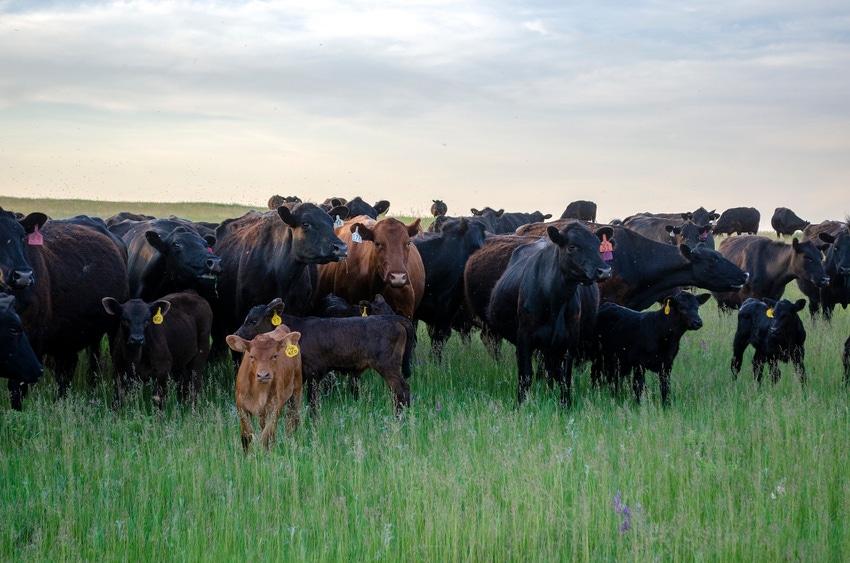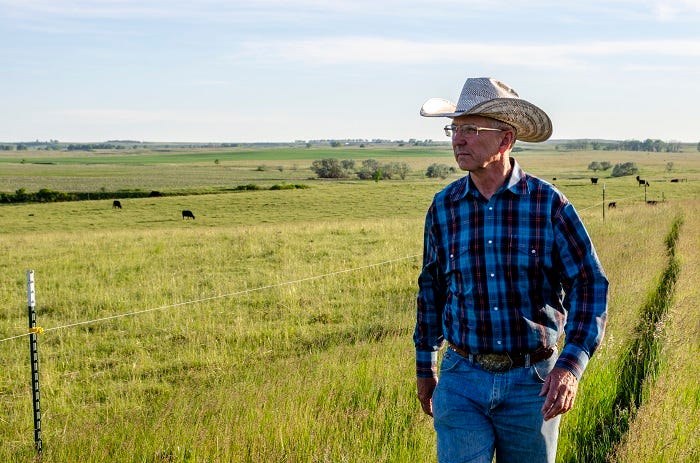
Jerry Doan of the Black Leg Ranch in southern North Dakota recently gave a talk about the 10 things that have built ranch profits most strongly for his family.
All four of his children, now adults, now work on the ranch in various jobs and niches, and the Doans have expanded the size of the ranch, as well. Here is his top-10 list.
1. Use holistic management. This is about how to think, Doan says.
"I think they train us wrong in higher education. We're trained to think in black and white, and there's nothing on a ranch that's black and white," he says.
Holistic management (HM) forms the basis for all decision making on the Black Leg Ranch and all the Doans have been trained in HM. He says the problem with our education system is it piles bits and pieces of knowledge on us, but doesn't teach us how to analyze or think about what we know.
"It's not perfect," Doan adds, "but I tell people all the time I don't care if you're never going to graze a cow, go through a holistic management course, just because it will teach you how to think again."
Further, he says, it will help you set real goals that make a difference for your family, your ranch, and your community.
2. Use planned rotational grazing. When the grazing is done well, everything gets better, Doan says. Plant diversity is better, production is better, the soil gets covered with plant life and litter, tallgrass species begin to flourish, and water quality improves.
The key, Doan says, is high animal impact, short duration of grazing, and long recovery periods. This is what creates healthy soil and biological capital for future production.
"Years and years of season-long grazing had narrowed the diversity to where it just wasn't very productive," Doan says. "It didn't look that bad, but the productivity had gone away and you just settle for what you get."
All that changed with the grazing management changes, he says.
3. Concentrate on production per acre. The Doans quit breeding big cows a long time ago and began to breed for and keep the cows that worked and reproduced on their ranch, with low inputs.
"Our production model of chasing weaning weights and such is a flawed model, and it's broke a lot of people," Doan says. "That's why we don't have any young people."
Doan notes he may not be able to brag about weaning weights, but he could brag about profitability if he wanted.

4. Calve in synch with nature. Like many others in their region, the Doans calved heifers in barns in the winter and cows soon after that. One year they lost 100 calves to scours. Doan says he decided to do something different or quit ranching about that time, because he wasn't having fun anymore.
"I went to the NDSU animal science department head and said give me all the research you have on calving later in the summer. I got a half a page."
But he pressed forward. He asked himself why he was fighting mother nature. Nowadays they're not, he says. They calve on green grass and things are easier and quality of life is much better.
"That was the number one economic decision I've ever made on that ranch," he adds.
5. Get cattle type right for your system. "We chased EPDs for growth and milk and all that stuff and it about broke us," Doan says.
Therefore they brought those cows down in size, quit feeding corn and other crutches to heifers to get them bred, and they are making progress, he says. They still have problems, particularly with getting heifers bred, but they have really reduced input costs, Doan says.
"We continue to select from heifers to get the type of heifer that will breed in this system," he adds.
6. Use low-maintenance bulls. These bulls must have calving ease and longevity. For the Doans, this also fits the cow size issue they are working on. It's about having the bulls produce the kind of cows that work on the ranch.
7. Adopt no-till farming methods for farmland. Doan says he was a skeptic when no-till production first showed up, but he has found it conserves moisture, reduces runoff and helps conserve soil. This was actually a starting place for improving their farmland.
"We have found it conserves moisture, reduces run off, helps with infiltration, and conserves soil," he says.
8. Regenerate all your soils. The basic tools for accomplishing regeneration on farmland, above and beyond the no-till starting place, are threefold, Doan says.
Multi-species cover crops
Crop rotations
Planned grazing
Multiple species build soil life and mycorrhizal fungi. Crop rotations build crop health. Planned grazing increases bioavailability of nutrients in the soil.
9. Winter grazing of cover crops can cut hay costs. The highest cost for cattle producers in the northern plains is winter feed costs. When they decided to follow this path, the Doans decided to set three goals for this winter grazing attempt. First, they planned how to lower winter feeding costs. Second, they wanted to further build soil health. Third, they wanted to improve wildlife numbers and habitat.
They have found this averages a savings of $200 per head per cow, or more. The quality of the forage is good enough, and they have grazed through some winters that totaled 100 inches of snow. They also went from putting up 5,000 bales of hay to about 800 bales of hay for the hardest winters.
Doan notes they also have a backup plan in a reserve of hay for drought or winter storms because they know drought can cut their cover crops, and therefore their winter grazing.

10. Develop niches and find your unfair advantages. Besides developing a low-cost, good-return livestock operation, the Doans have jumped into guided hunts and agrotourism. First, they refurbished the old family home, a ranch house built in early 1900's from a Sears and Roebuck kit house. That became the Grand Lodge.
Next, they remodeled an old barn on the ranch for an event center to host guests, weddings, corporate events, soil and grazing tours and educational events. This they call the Copper Jewell barn, named after both Jerry's father and grandfather, who shared the first name of Jewell. This keeps family history and nostalgia and also shares it with the guests.
They are experimenting with marketing grass-finished beef and home-brewed beer. Incidentally, each of the three sons and the Doan's daughter have their niche area of specialty.
They also do some custom grazing to develop cash flow. They are exploring multi-species grazing with sheep and bison.
About the Author(s)
You May Also Like




